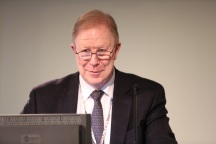Professor Adrian K Dixon was born in the same year that the NHS began. Here he reflects on what the NHS has given him and the revolution he has experienced in the world of radiology.

Professor Adrian K Dixon
I was born in 1948 and, 70 years on, I remain one of the most passionate supporters of the NHS. Like many of my generation, I have received huge personal benefit from the NHS over the years; both my elbow fractures were brilliantly treated in Accident and Emergency Units; joint replacements for osteoarthritis have provided renewed mobility latterly; audiology services have looked after my long-term inherited deafness and allowed me to function reasonably well so far.
Training in medicine in Cambridge (1966–9) and London (St Bartholomew’s Hospital, 1969–72) was very different from nowadays. On hour one, day one, as a young houseman, sister said to me: “There are three patients for myelography today – there are three trays set up for lumbar puncture – all you have to do is to send some cerebrospinal (CSF) fluid off to the lab and instil the Myodil before they go down to radiology where Professor du Boulay will be waiting….!” I had not even seen a lumbar puncture at that stage but I learnt quickly at the hands of an excellent registrar. Then I went off for training in General Medicine at Nottingham General Hospital in the excellent Professorial Unit led by Professor Mitchell and Dr (later Professor) Hampton. Any patient over 65 then was ‘geriatric’. I well remember one elderly lady recovering from a cardiac event who was not quite well enough to go home where she lived alone – I said: “I think you need a few days in our convalescent home in Cleethorpes (yes, the NHS provided such things in those days!)”. Her reply: “Oh lovely; I have never seen the sea”. No package holidays or low-cost flights back then!
I was extremely lucky to train in radiology during the 1970s and to be involved with the beginning of the revolution in imaging, namely the introduction of ultrasound, CT and MRI. These advances were truly miraculous compared with the fluoroscopic techniques of old. Indeed image intensification was only just becoming sophisticated while I was training and I did my fair share of barium work using direct fluoroscopy following dark adaptation with red goggles! This even persisted after my move to Cambridge when I was given responsibility for imaging services at the local geriatric hospital where the ageing equipment was nearly as old as some of the patients!

After a brief spell in paediatric radiology, I became fascinated by Computed Tomography and I was lucky to be appointed as a Research Fellow at St Bartholomew’s Hospital. There, Dr Ian Kelsey Fry had the foresight to install one cranial and one whole body CT systeminto 2 standard X-ray rooms (an excellent strategy – replacing old technology rather than merely adding on the new). This gave me the experience to be appointed as a young lecturer/Honorary Consultant at the newly emerging Clinical School in Cambridge (thanks to the risk taken by my lifelong friend Professor Tom Sherwood).
In partnership with NHS radiological stars in Cambridge (Desmond Hawkins and Chris Flower, to name but two), Tom Sherwood forged a highly successful combined University/NHS Radiology Department which continues to this day. I was fortunate to be given free rein to develop Body CT and the townspeople generously raised the money for a machine which was opened by HRH the Prince of Wales in 1981. But the NHS was not quite ready for CT! Not only did the town-based charity have to pay for the building, it also had to provide running costs for the first five years; we only received subsequent NHS funding in 1986 after a thorough Department of Health Audit of our work. Even then the local NHS was sceptical; the local oncologists saved the day by suggesting that they could manage more of their patients as outpatients if CT was available. The outstanding local fundraisers were so successful that the charity was able to fund top-of-the range MRI systems in Cambridge for some decades thereafter. Although there was one generous distribution of NHS funding for CT systems on the back of Sir Mike Richards’ cancer initiatives, NHS funding for high-end equipment has never really been properly addressed.
About Professor Adrian K Dixon

Professor Adrian K Dixon
Professor Dixon is Emeritus Professor of Radiology at the University of Cambridge and a retired Consultant Radiologist. He has published extensively on Computed Tomography and Magnetic Resonance Imaging and has edited several textbooks. He was Warden of the Royal College of Radiologists (Clinical Radiology, 2002–2006) and MR Clinical Guardian to the UK Department of Health (2004–2007). He has been awarded honorary Fellowship/Membership of Radiological Societies in Austria, Australia & New Zealand, France, Hungary, Ireland, Sweden, Switzerland and the USA. He was Editor-in-Chief of European Radiology 2007–12 and was awarded the Gold Medal of the European Society of Radiology in 2014. He has been awarded Honorary Degrees by Munich and Cork. He was Master of Peterhouse, University of Cambridge 2008–2016.


Lovely poost